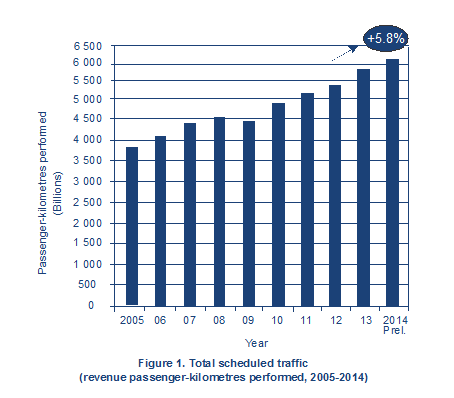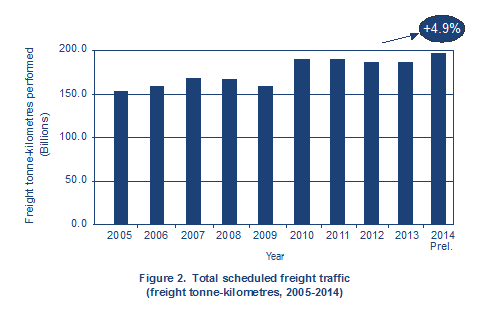The World of Air Transport in 2014
In 2014 the total number of passengers carried on scheduled services rose to 3.3 billion, which is 5.5 per cent higher than last year, according to preliminary statistics compiled by ICAO. The number of departures reached 33 million globally in 2014, a 2.1 per cent increase compared to 2013. Detailed air transport statistics appear in Appendix 1.
Passenger traffic, expressed in terms of total scheduled revenue passenger-kilometres performed (RPK), posted an increase of 5.8 per cent with approximately 6 145 billion RPKs performed in 2014. Asia/Pacific remained the largest region with 32 per cent of world traffic, posting a 7.0 per cent growth in 2014, followed by Europe with 27 per cent of world traffic and growth of 6.0 per cent over 2013. North America, which accounts for 25 per cent of world traffic, grew at 3.0 per cent. The Middle East region once again recorded the highest growth rate at 11.3 per cent, representing 9.0 per cent of world traffic. The Latin America/Caribbean region accounted for 5.0 per cent of world traffic and grew at 5.3 per cent. The remaining world traffic (2.0 per cent) was performed by airlines of the African region with growth of 0.8 per cent in 2014.
International scheduled passenger traffic grew by 6.0 per cent in RPKs in 2014, up from the 5.7 per cent recorded in 2013. Europe increased by 5.9 per cent and accounted for the largest share of international RPKs with 38 per cent. Asia/Pacific had the second largest share with 28 per cent, and grew by 5.8 per cent. The Middle East Region recorded the fastest growth of 11.5 per cent compared to 2013. Carriers in Africa experienced the slowest growth rate of 0.6 per cent.
In terms of domestic scheduled air services, overall markets grew by 5.6 per cent in 2014. North America, the world’s largest domestic market with 44 per cent of the world domestic scheduled traffic, experienced 3.1 per cent growth in 2014. The Asia/Pacific region, which accounted for 38 per cent of world domestic scheduled traffic, grew strongly by 8.4 per cent in 2014 mainly due to an increase of 11.2 per cent in the domestic Chinese market and 7.9 per cent in the domestic Indian market.
Low-cost carriers carried an estimated 900 million passengers in 2014, which is around 27 per cent of the world total scheduled passengers. This indicated a 10.3 per cent growth when compared to the number of passengers carried by low-cost carriers in 2013 which was almost double the world total average passenger growth rate.
The 5.8 per cent growth observed in scheduled passenger traffic in 2014, compared to the 5.5 per cent growth in 2013, has to be viewed against World Bank estimates which indicate slight improvement in world real gross domestic product (GDP), from 2.5 per cent growth in 2013, to 2.6 per cent in 2014. In 2014, economic growth improved in the high-income European region and the United States, resulting in higher traffic growth in these States. Continued strong international traffic expansion was also observed in the United Arab Emirates and China, and strong growth was experienced in domestic traffic in both the Russian Federation and India. All of these positives offset the negative impact on traffic of overall economic weakness in other regions and low commodity prices in 2014.
Capacity offered by the world’s airlines, expressed as available seat-kilometres, increased globally by 5.6 per cent. While capacity growth ranged from 2.7 per cent in North America to 10.9 per cent in the Middle East, the average global passenger load factor improved by 0.2 percentage points over 2013, ranging from 68.6 per cent for Africa to 83.4 per cent for North America. The average passenger global load factor reached 79.7 per cent in 2014. Air carriers in all regions with the exception of Africa have been increasingly successful in optimizing their available capacity.

After nearly two years of negative or almost flat growth, scheduled total freight traffic rebounded in 2014, in line with improving economic prospects. Air freight, expressed in terms of scheduled total freight tonne-kilometres performed, posted an increase of 4.9 per cent. Approximately 50 million tonnes of freight were carried in 2014. Middle East carriers recorded overall double digit growth rates of 12.1 per cent. Africa grew at 6.0 per cent while Asia/Pacific increased by 5.5 per cent. North America, Europe and Latin America and the Caribbean grew at 3.2 per cent, 2.0 per cent and 1.2 per cent, respectively.
Scheduled international freight tonne-kilometres performed posted an increase of 5.2 per cent with approximately 33 million tonnes of freight carried in 2014. International air freight represented around 86 per cent of total scheduled freight tonne-kilometres performed. Nearly 96 per cent of international scheduled freight tonne-kilometres performed was carried by air carriers in Asia/Pacific (41 per cent), Europe (25 per cent), North America (15 per cent) and the Middle East (15 per cent), which indicates the impact that East-West trade lanes have on international freight traffic. It is estimated that nearly 80 per cent of long-haul freight traffic flows on this important trade lane that connects Asia to Europe, Asia to North America and which connects Europe to North America.
Scheduled international freight capacity, expressed in freight tonne-kilometres available, offered in 2014 was around 330 billion, being 5.0 per cent growth compared to 2013. The scheduled international freight load factor remained at 49.7 per cent, which was the same as in 2013.
Based on available figures, ICAO is estimating an operating profit of about 5.5 per cent on operating revenues for scheduled airlines of Member States. The operating profit is expected to be around USD 42 billion in 2014 based on operating revenues of USD 758 billion. Nearly a third of global operating profits came from the performance of air carriers in North America. The average jet fuel price in 2014 was 78.7 US cents/litre, which was a decrease of around 6.9 per cent over 2013, and contributed to improved profitability for the industry. Despite improving financial figures, the industry is plagued by low margins that reflect the intense competitive pressures faced by the industry. A detailed variance analysis of changes in operating profits in 2014 compared to 2013 appears in Appendix 1, Table 9.

After 2.6 per cent growth in real GDP, the World Bank has forecast the GDP to further recover in 2015 and is projected to grow at 3.0 per cent. Accordingly, ICAO has forecast world international passenger traffic to grow at about 6.7 per cent in the same year.
The operating profit for the industry is expected to increase to around USD 48 billion in 2015 due to the combined effects of improving economic growth and lower jet fuel prices that could be offset to some extent by reduction in yields.
Global air traffic has doubled in size every 15 years since 1977, and it is expected that between now and 2030 the numbers will double again. The 3.3 billion airline passengers carried in 2014 are expected to grow to about six billion by 2030, and the number of departures is projected to rise to some 60 million in 2030. The latest forecasts are contained in the Global Air Transport Outlook to 2030 and trends to 2040 (Circular 333).
With regard to new aircraft, the world’s major manufacturers delivered about 1 600 new commercial aircraft in 2014 and have recorded net orders for about 3 100 new aircraft. Production is at record levels, and with book-to-bill ratios of around 2:1, order backlogs are expected to continue growing. While the declining price of jet fuel could dampen demand for new aircraft, traffic growth projections, low borrowing costs, improving airline profitability and the fleet replacement programmes of many carriers are expected to maintain the strength of the aircraft market.
As for aviation safety, there were 98 aircraft accidents for scheduled air services in 2014, an increase of 9.0 per cent from 2013, when 90 accidents were reported. This is according to an analysis of global safety data involving commercial air transport aircraft with a maximum certificated take-off mass of more than 5 700 kilograms. The number of fatalities in scheduled operations worldwide increased to 904 fatalities, from 173 in 2013, the highest number in the previous five years. This is due in large part to the tragic accidents involving MH370 and MH17. However, the number of fatal accidents decreased in 2014 to just 7, the lowest in recent history. The global accident rate increased slightly to 3 accidents per million schedule departures versus 2.8 accidents per million scheduled departures in 2013.
Non-scheduled commercial passenger operations experienced 41 accidents (9 fatal), compared with 27 accidents in the previous year (based on preliminary data). The number of passenger fatalities associated with non-scheduled commercial operations decreased to 41 from 47 in 2013. Accident rates for non-scheduled operations could not be estimated because of the lack of comprehensive traffic figures related to such services.
With regard to acts of unlawful interference, 20 incidents were recorded in 2014. These included 9 facility attacks targeting landside areas and infrastructures of airports, 2 unlawful seizures, 2 attempted seizures, 2 in-flight attacks, 1 attempted sabotage of a helicopter and 4 other acts, including a forced entry through an airport perimeter fence. Details concerning all 2014 events are available in the Acts of Unlawful Interference Database which is accessible at ICAO’s secure website.
More comprehensive safety data are available at http://www.icao.int/safety/iStars/.
